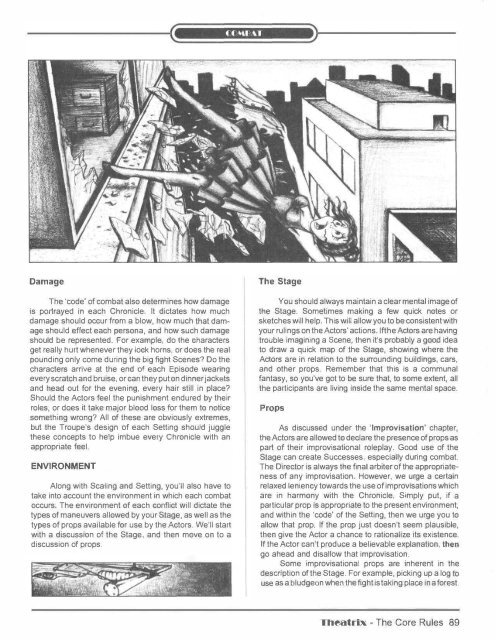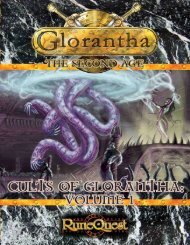Untitled - Index of - Free
Untitled - Index of - Free
Untitled - Index of - Free
Create successful ePaper yourself
Turn your PDF publications into a flip-book with our unique Google optimized e-Paper software.
Damage<br />
The 'code' <strong>of</strong> combat also determines how damage<br />
is portrayed in each Chronicle. It dictates how much<br />
damage should occur from a blow, how much that dam<br />
age should effect each persona, and how such damage<br />
should be represented. For example, do the characters<br />
get really hurt whenever they lock horns, or does the real<br />
pounding only come during the big fight Scenes? Do the<br />
characters arrive at the end <strong>of</strong> each Episode wearing<br />
every scratch and bruise, or can they put on dinner jackets<br />
and head out for the evening, every hair still in place?<br />
Should the Actors feel the punishment endured by their<br />
roles, or does it take major blood loss for them to notice<br />
something wrong? All <strong>of</strong> these are obviously extremes,<br />
but the Troupe's design <strong>of</strong> each Setting should juggle<br />
these concepts to help imbue every Chronicle with an<br />
appropriate feel.<br />
ENVIRONMENT<br />
Along with Scaling and Setting, you'll also have to<br />
take into account the environment in which each combat<br />
occurs. The environment <strong>of</strong> each conflict will dictate the<br />
types <strong>of</strong> maneuvers allowed by your Stage, as well as the<br />
types <strong>of</strong> props available for use by the Actors. We'll start<br />
with a discussion <strong>of</strong> the Stage, and then move on to a<br />
discussion <strong>of</strong> props.<br />
The Stage<br />
You should always maintain a clear mental image <strong>of</strong><br />
the Stage. Sometimes making a few quick notes or<br />
sketches will help. This will allow you to be consistent with<br />
your rulings on the Actors' actions. lfthe Actors are having<br />
trouble imagining a Scene, then it's probably a good idea<br />
to draw a quick map <strong>of</strong> the Stage, showing where the<br />
Actors are in relation to the surrounding buildings, cars,<br />
and other props. Remember that this is a communal<br />
fantasy, so you've got to be sure that, to some extent, all<br />
the participants are living inside the same mental space.<br />
Props<br />
As discussed under the 'Improvisation' chapter,<br />
the Actors are allowed to declare the presence <strong>of</strong> props as<br />
part <strong>of</strong> their improvisational roleplay. Good use <strong>of</strong> the<br />
Stage can create Successes, especially during combat.<br />
The Director is always the final arbiter <strong>of</strong> the appropriate<br />
ness <strong>of</strong> any improvisation. However, we urge a certain<br />
relaxed leniency towards the use <strong>of</strong> improvisations which<br />
are in harmony with the Chronicle. Simply put, if a<br />
particular prop is appropriate to the present environment,<br />
and within the 'code' <strong>of</strong> the Setting, then we urge you to<br />
allow that prop. If the prop just doesn't seem plausible,<br />
then give the Actor a chance to rationalize its existence.<br />
If the Actor can't produce a believable explanation, then<br />
go ahead and disallow that improvisation.<br />
Some improvisational props are inherent in the<br />
description <strong>of</strong> the Stage. For example, picking up a log to<br />
use as a bludgeon when the fight is taking place in a forest.<br />
Theatrix - The Core Rules 89



